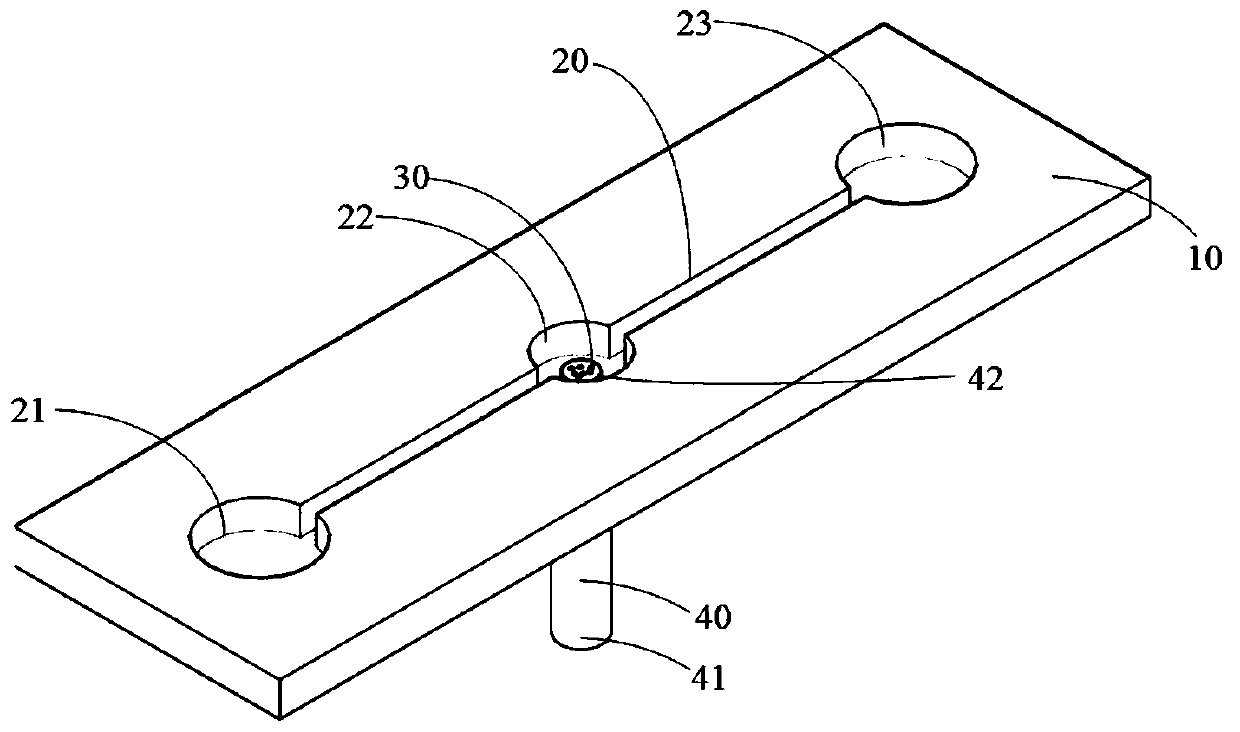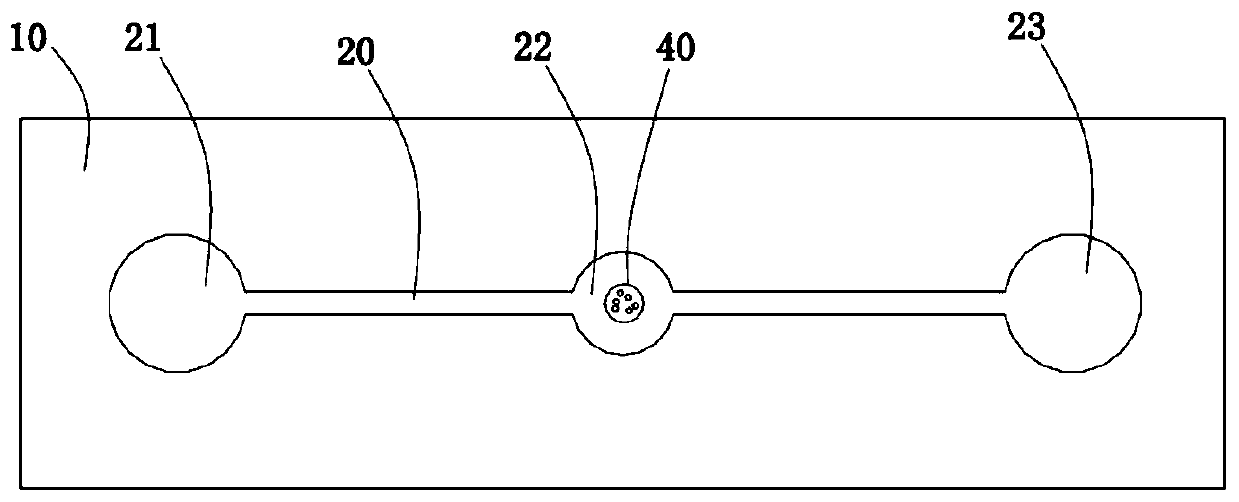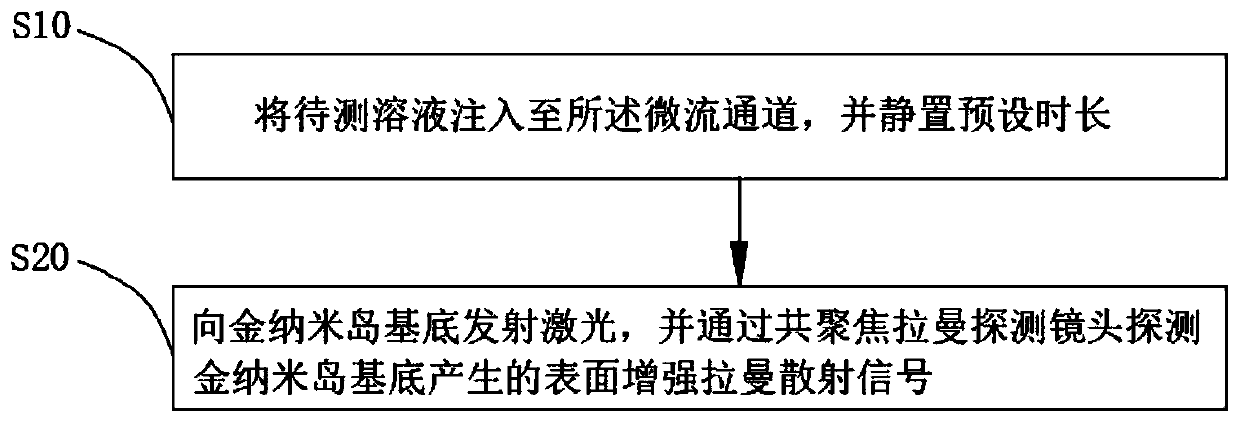Surface enhanced Raman scattering optical flow chip and cleaning method thereof
A surface-enhanced Raman and optical flow technology, applied in the field of optofluidic detection, can solve the problems of limiting the sensitivity and repeatability of optical fiber substrates, limiting the application of SERS detection, limiting miniaturization and integration, and achieving trace detection , reusable, and reproducible effects
- Summary
- Abstract
- Description
- Claims
- Application Information
AI Technical Summary
Problems solved by technology
Method used
Image
Examples
Embodiment 1
[0056] like figure 1 As shown, the surface-enhanced Raman scattering optical flow chip according to the first embodiment of the present invention includes a substrate 10 , a microfluidic channel 20 , a metal nano-island substrate 30 and an optical fiber 40 . The microfluidic channel 20 is disposed in the substrate 10, and the microfluidic channel 20 is used to accommodate the solution to be detected; the optical fiber 40 includes an optical signal input end 41 and an excitation end 42, and the optical signal input end 41 is used to connect the optical signal, and the excitation end 42 is arranged in the microfluidic channel 20 . The metal nano-island substrate 30 is formed on the end face of the excitation end 42 , wherein the metal nano-island substrate 30 is used to generate surface plasmon resonance under the excitation of an external laser, so as to adsorb the substance molecules in the solution to be detected. After the detection is completed, the optical signal is conne...
Embodiment 2
[0066] like image 3 As shown, according to the second embodiment of the present invention, the detection method of the surface-enhanced Raman scattering optical flow chip includes the following steps:
[0067] Step S10: inject the solution to be tested into the microfluidic channel 20, and let it stand for a preset period of time.
[0068] Specifically, the solution to be detected is injected from the injection port 21 using a syringe pump, so that the solution to be detected fills the microfluidic channel. It was left to stand for one minute so that the substance molecules were completely adsorbed on the metal nano-island substrate 30 . The solution to be detected is a solution containing the substance to be detected. In order to make the detection accuracy more sensitive, it is recommended to use pure substance or its aqueous solution as the solvent, and in order to make the substance molecules to be detected have better adsorption on the SERS substrate , Exemplarily, the...
Embodiment 3
[0085] like Figure 7 As shown, the cleaning method of the surface-enhanced Raman scattering optical flow chip according to the third embodiment of the present invention includes the following steps:
[0086] Step S100: Pour deionized water into the microfluidic channel 20, and make the deionized water submerge the metal nano-island substrate.
[0087] Specifically, a syringe pump is used to inject deionized water from the inlet, and the remaining solution in the channel after detection is taken out of the channel. When the chip is in a cleaning state, the cleaning liquid is deionized water.
[0088] Step S200 : connecting the optical signal to the optical signal input end 41 , turning off the optical signal after a predetermined period of time, and removing the deionized water in the microfluidic channel 20 .
[0089] Specifically, when the optical fiber 40 passes light, because the metal nano-island substrate 30 has a good photothermal effect, heat will be generated on the ...
PUM
| Property | Measurement | Unit |
|---|---|---|
| thickness | aaaaa | aaaaa |
| power | aaaaa | aaaaa |
| wavelength | aaaaa | aaaaa |
Abstract
Description
Claims
Application Information
 Login to View More
Login to View More - R&D
- Intellectual Property
- Life Sciences
- Materials
- Tech Scout
- Unparalleled Data Quality
- Higher Quality Content
- 60% Fewer Hallucinations
Browse by: Latest US Patents, China's latest patents, Technical Efficacy Thesaurus, Application Domain, Technology Topic, Popular Technical Reports.
© 2025 PatSnap. All rights reserved.Legal|Privacy policy|Modern Slavery Act Transparency Statement|Sitemap|About US| Contact US: help@patsnap.com



